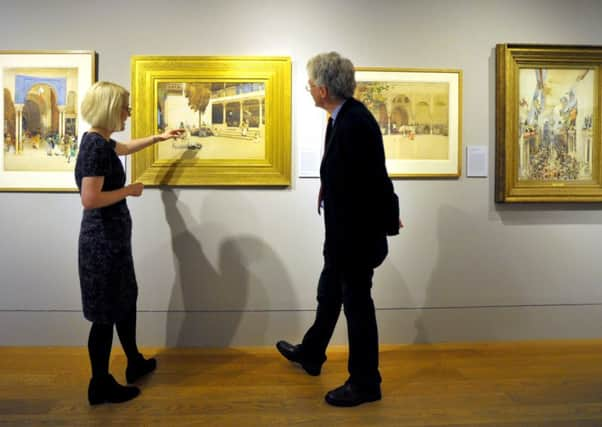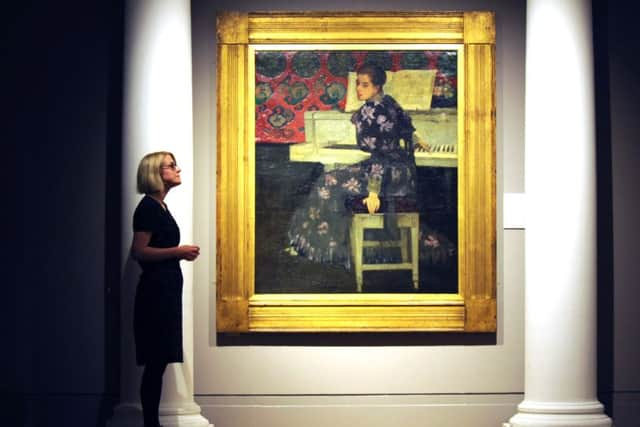Art review: Arthur Melville: Adventures in Colour, Edinburgh


Arthur Melville: Adventures in Colour
National Gallery of Scotland, Edinburgh
Rating: *****


When artists’ reputations are established, we call them by a single name. We talk easily of Peploe, Cadell or Fergusson, for instance, but although Arthur Melville was the primary inspiration of the Colourists, and before them of the Glasgow painters who were his younger contemporaries, we still give him his whole name: Arthur Melville. It is not that he is a new discovery. Far from it. His work has always been admired. It is simply that somehow he has never taken the place in popular consciousness that he so richly deserves. He was one of the most original painters of his time, and not just in Scotland. Perhaps the National Galleries’ exhibition of his astonishing, luminous paintings will at last make his name familiar.
One reason for its lack of familiarity may be that much of his work is in watercolour and the old prejudice that it is a secondary medium still lurks somewhere. Perhaps, too, as you can’t hang a watercolour in a brightly lit room, the medium hides its light under a bushel. But Melville defied prejudice and painted in watercolour because it has a unique luminosity which he exploited to paint light with extraordinary brilliance. He also painted on a scale, both of execution and conception, and framed his pictures with such bold originality that his watercolours can hold their own on any wall. Indeed the only serious criticism of this show is that his work is cramped in the lower galleries of the RSA. His watercolours need space.
Advertisement
Hide AdMelville was born in Angus, brought up in East Lothian and studied in Edinburgh before going to Paris in 1878. A small, early painting of a cabbage patch and a big picture exhibited at the RSA in 1881 of children in a French market, shielded by their mother from an aggressive turkey cock, show that he set out as a painter in oils in the contemporary Realist manner. The Royal Scottish Watercolour Society was founded in 1878 however. William McTaggart was a leading figure and so Melville’s interest in the medium may have predated his sojourn in France. Certainly by 1880, a painting of a scene outside a Paris wine shop already shows the originality of his approach and his characteristic interest in strong contrasts of light and shade.
Melville was a charismatic figure, a sportsman and an adventurer, and after Paris his next move was to follow in Wilkie’s footsteps to the Middle East, first to Egypt, very briefly to India, then to the Persian Gulf and perilously back overland from Baghdad to Constantinople. Middle Eastern subjects were his main subject for some years thereafter and in them his technique became increasingly bold. A small picture painted on this trip during a fleeting visit to Karachi already shows what was to become his characteristic procedure – christened blottesque – of dropping paint on to the paper in unbrushed blobs. Often these blobs are only connected by the white of the paper to suggest forms dissolved by dazzling light. He further developed this technique to drop wet paint into a ground of wet Chinese white, thus preserving the dense colour of unbrushed, unmixed pigment. He also lifts wet paint off the white ground with a sponge to suggest shimmering veils of shadow. You see the dazzling impact of this technique in Arab scenes like The Procession, and Awaiting an Audience with the Pasha, both of the1880s, but also in a wonderful Scottish painting, Skating on Duddingston Loch. Figures at the edge of the ice are just blobs, while, created with a sweep of the brush like a piece of Japanese calligraphy, an isolated woman skater challenges the elegance of Raeburn’s skating minister.
Melville’s art is at its most glorious in his great watercolours of the 1890s, however. He created radically new images of Scotland in pictures like Autumn Loch Lomond, or in the grand and atmospheric Stones of Stenness, the latter framed in gilded planks of unplaned pine. He painted in Venice, too, and his picture of the tall Campanile of St Marks disappearing into a deep blue night sky is a homage to his friend Whistler’s Nocturnes but is also a glorious, poetic vision that is wholly his own.
To refresh his inspiration, he travelled to Spain and North Africa. In Corpus Christi Toledo, he describes a vast scene under the filtered light of high canopies hung to shade the crowded streets of this summer festival. Then in pictures like Tangier or The Sapphire Sea, the latter a coastal scene in Spain, he paints brilliant sunlight and the intense colour it creates as no-one had done before him, but he also composes with increasing boldness and originality. If you didn’t know what it was, you would suppose the upper half of Tangier was a piece of post-Cubist painting, but it is dated 1893. Gorge de Passages, a view of a little port in Spain, is also as flat and vertical as a Cubist picture.
But perhaps we shouldn’t see Melville only in the French context these comparisons suggest. His blotting technique adapted for watercolour a method that the Pre-Raphaelites had developed for oil to try to capture the true brilliance and true colour of sunlight – look at Holman Hunt’s Hireling Shepherd, for instance – and so perhaps if we see Melville as some kind of Impressionist, blinded by hindsight we miss the point. His passion for light and pure colour and his extraordinary decorative sense suggest the inspiration of the Pre-Raphaelites as much as of Monet, and they were after all also the starting point for McTaggart. His work is a synthesis of both traditions. This is striking in his oil paintings, too, as he took up the technique again in the Nineties. Indeed the White Piano is a big portrait of a woman seated at the piano, but its startling, flat, decorative composition stands somewhere between Rossetti and Matisse. In oils, like the Contrabandista, or the Chalk Cutting, he is even more abstract. He draws, not just with the brush, but with the contours of the paint the brush creates. The surface is in patterned relief. In this as in so much else, his modernity was extraordinary. Tragically works like these were to be his last. He died of typhoid in 1904 aged just 49.
• Arthur Melville: Adventures in Colour is at the National Gallery until 17 January